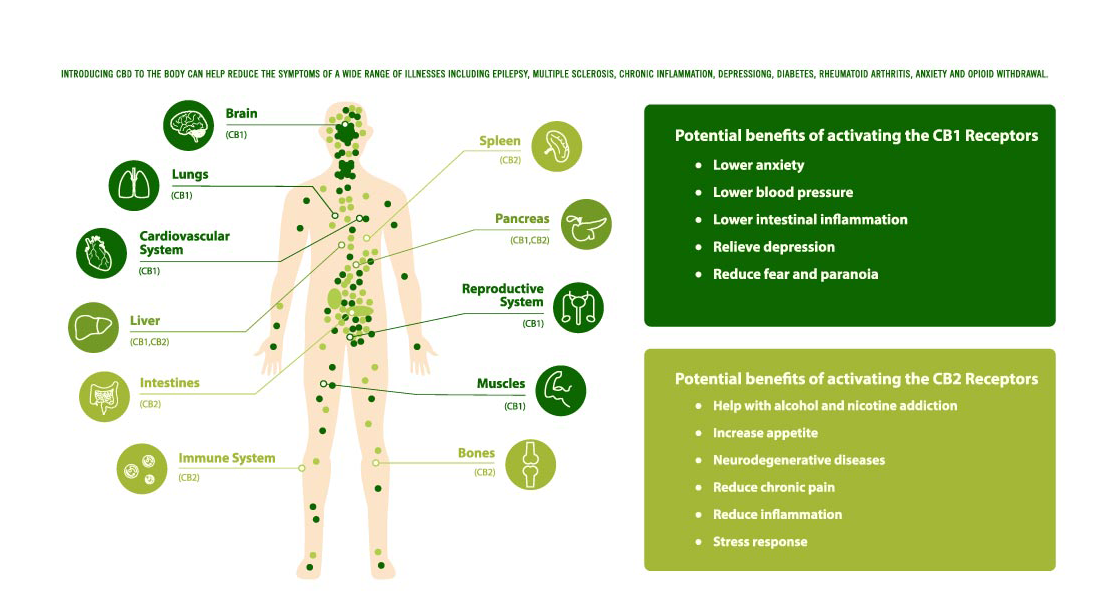
The use of the Cannabis sativa, or hemp plant, can be traced back to the beginnings of recorded human history. Research into the chemistry and mechanisms of action of this medicinal herb has only occurred relatively recently. Cannabinoids are a specific class of at least 113 compounds that have been identified in hemp and cannabis, including the most well-known, THC and CBD. CBD, short for cannabidiol, was first isolated in the 1930s. The isolation of THC and descriptions of their structures would follow in the early 1960s. Further understanding would come to light with the identification of cannabinoid receptors in the mid-1980s and the identification of the first endocannabinoid, a cannabinoid-like compound produced in our own bodies, in the early 1990’s1. These landmark discoveries in the world of cannabis research initiated our understanding of what would come to be known as the endocannabinoid system or ECS. The ECS is an expansive and complex cell signaling network of receptors, endocannabinoids, and enzymes within our bodies that is intimately involved in establishing and maintaining human health and homeostasis. This foundational work launched a flurry of scientific inquiry in recent years that promises to bring us closer to understanding the relationship between cannabinoids and the ECS.
We can divide the ECS into three main parts as a signaling network. These parts include the endocannabinoids, which are the signaling molecules, the receptors, and the proteins and enzymes that either inhibit or break down the endocannabinoids after they have completed their functions. The two key endocannabinoids are anandamide (AEA) and 2-arachidonoylglycerol (2-AG), ligands or binding molecules that are biosynthesized on-demand in the postsynaptic terminals and that act at the receptor sites. The main receptors associated with the ECS are of a specific type known as G-protein-coupled receptors and are named CB1 and CB2 for cannabinoid receptors 1 and 2 respectively. These receptors are located throughout the body with CB1 found most densely in our central nervous system while CB2 receptors are more concentrated in the peripheral nervous system and immune cells. The final part of this simplified ECS picture consists of the enzymes and proteins that either break down the endocannabinoids or prevent their further action. While these may be the basic building blocks of our ECS, how these pieces interact and the existence of interactions with many other compounds and signaling pathways is an ever-evolving area of research2.
Research has linked the ECS to numerous functions including sleep, learning and memory, motor control, mood regulation, pain and inflammation, immune response, metabolism, appetite and digestion, stress, and neuroprotection and neuroplasticity3. CBD is the major non-psychotropic component of the hemp plant and has displayed therapeutic promise for a wide range of ailments in both anecdotal and preclinical reports. The questions of great practical interest remain. How does CBD work in the body? What does it even do? The answer? Well… it’s not so simple.
CBD has been identified in several studies to have anticonvulsant ( anti-seizure), anti-inflammatory, antioxidant, antiemetic (anti-nausea/vomiting), anxiolytic (anxiety-reducing), and antipsychotic properties. CBD acts differently within the ECS than THC and its action is arguably less understood. Whereas THC binds as an agonist with the ECS receptors, CBD is thought to act as an inverse agonist and a negative allosteric modulator of both the CB1 and CB2 receptors. An inverse agonist is a ligand that binds to the same receptor as an agonist but acts oppositely. An allosteric modulator binds to the receptor and changes its response to stimuli. Additionally, CBD is thought to inhibit the action of FAAH, one of the enzymes responsible for breaking down endocannabinoids, thus increasing anandamide levels. This would indicate, at least in a simplistic view, that CBD works by preventing the breakdown of endocannabinoids, allowing them to work to a different degree within the body. CBD has also been found to act on other receptors; as an agonist to TRPV1, PPAR𝛾, and 5-HT1A and an antagonist to receptor GPR554. This broad range of activity may help to explain the wide range of effects reported by CBD users and the extensive potential for CBD as a compound of medicinal interest.
To date, preliminary research has identified the ECS as an important component of numerous biological processes. In general, the endocannabinoid system plays a significant role in maintaining homeostasis, the balance that ensures equilibrium in our physiological processes. As the body of research into CBD and the ECS continues to grow we hope to see the gap between anecdotal reports of effectiveness and scientific literature narrow significantly. The future of CBD as a valuable and natural pharmacological compound grows brighter with every advance in endocannabinoid research.
Sources: